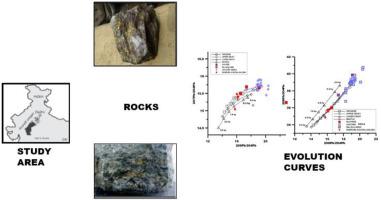Applied Geochemistry ( IF 3.4 ) Pub Date : 2021-03-31 , DOI: 10.1016/j.apgeochem.2021.104938 Avijit Das , Krishnapriya Basak , Subhra Sarita Patel , Dipayan Guha

|
A comprehensive lead isotopic database of the Khetri Copper Belt (KCB), Rajasthan, India has been constructed by analyzing the area's ore, minerals, mine water, plant parts, host and country rocks for the evaluation of the deposits in terms of its age of formation and using the database in a preliminary test case of mineral prospecting in neighbouring Haryana. KCB lies in the northeastern part of the Proterozoic Delhi Fold Belt and has been well researched because it houses India's largest copper repository in Madan Kudan, Kolihan and Chandmari mines in its northern part. The lead isotopic profiling conclusively proves repeated metamorphic occurrences in the study area and that Pb in the ore and other rock-forming minerals evolved in a high μ (238U/204Pb) environment of the upper crust. Whereas the 207Pb/206Pb and 208Pb/206Pb ratios of the sulphides of the Madan Kudan and Kolihan lodes of KCB are similar (0.8302–0.8372 and 2.0627–2.0646, respectively), the corresponding values for the Chandmari lode are 0.7209–0.7682 and 1.9463–2.1134. The evolution curves (207Pb/204Pb and 208Pb/204Pb against 206Pb/204 Pb) of KCB sulphides, country rocks, minerals and Indian galena samples, show two mixing lines and that the sulphides are younger (~800 Ma) to the older minerals like calcite, amphiboles and quartz. The first mixing line is formed from the clustering of Indian galena with the older minerals while sulphides and albitites cluster feebly in the second mixing line. There is no consistent correlation between Pb and U concentrations with the age of the different sulphides, country rocks, minerals. The sulphides of East Khetri Belt (EKCB), Muradpur, Bokri-Malwali and Papurna show exceeding variability in 206Pb/204Pb and 207Pb/204Pb ratios, indicating varying degrees of U enrichment of the source region. The mean 208Pb/204Pb, 207Pb/204Pb and 206Pb/204Pb values of the plant roots (37.489, 15.601, 17.614 respectively) are comparable with the corresponding values of mine water (37.138, 15.562, 17.230) indicating that these are isotopically similar. The 207Pb/204Pb and 208Pb/204Pb values of the leached soils from mineralized Golwa in Haryana cluster linearly with the East and North Khetri Copper Belt sulphides along with the soils of unmineralized Islampur-Sareli around 10 km away, thereby indicating the probability of a metallogenic zone in that area.
中文翻译:

印度拉贾斯坦邦Khetri铜带的Pb同位素评估及其作为探矿体扩展的工具
印度拉贾斯坦邦Khetri铜带(KCB)的综合铅同位素数据库已通过分析该地区的矿石,矿产,矿井水,植物部位,宿主和乡村岩石而建立,用于评估其成矿年龄。并在邻近哈里亚纳邦探矿的初步测试案例中使用该数据库。KCB位于元古代德里褶皱带的东北部,由于它在北部的Madan Kudan,Kolihan和Chandmari矿藏着印度最大的铜矿藏,因此得到了充分的研究。铅同位素分析最终证明了研究区内反复发生变质事件,矿石和其他成岩矿物中的Pb以高μ(238 U / 204铅)上地壳的环境。KCB的Madan Kudan矿和Kolihan矿的硫化物的207 Pb / 206 Pb和208 Pb / 206 Pb的比率相似(分别为0.8302–0.8372和2.0627–2.0646),而Chandmari矿的相应值为0.7209– 0.7682和1.9463-2.1134。演化曲线(207 Pb / 204 Pb和208 Pb / 204 Pb对206 Pb / 204 KCB硫化物,乡村岩石,矿物和印度方铅矿样品的Pb)显示出两条混合线,并且该硫化物比方解石,闪石和石英等较老的矿物更年轻(〜800 Ma)。第一混合线是由印度方铅矿和较旧的矿物聚集而成的,而硫化物和方铁矿则在第二混合线中聚集较弱。铅和铀的浓度与不同硫化物,乡村岩石,矿物的年龄之间没有一致的相关性。East Khetri Belt(EKCB),Muradpur,Bokri-Malwali和Papurna的硫化物在206 Pb / 204 Pb和207 Pb / 204 Pb之比上表现出极大的可变性,表明源区铀富集程度不同。均值208植物根的Pb / 204 Pb,207 Pb / 204 Pb和206 Pb / 204 Pb值(分别为37.489、15.601、17.614)与矿井水的相应值(37.138、15.562、17.230)可比,表明它们是同位素同位素相似的。哈里亚纳邦矿化的Golwa浸出土壤的207 Pb / 204 Pb和208 Pb / 204 Pb值与东和北Khetri铜带硫化物以及未矿化的Islampur-Sareli的土壤呈线性簇状关系,约10 km。该区域成矿带的可能性。



























 京公网安备 11010802027423号
京公网安备 11010802027423号